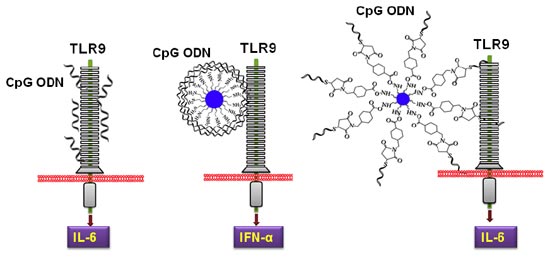Development of Technology that Enhances the Efficacy of Immunity-Activating Nucleic Acid Drugs Using Nanoparticles
Application to Treatment of Allergic Diseases and Infectious Diseases
2012.07.26
(2012.08.22 Update)
National Institute for Materials Science
The NIMS Nanotechnology Innovation Station succeeded in development of a technology that uses nanoparticles to enhance the action of immunity-activating nucleic acid drugs.
Abstract
- The Nanotechnology Innovation Station (Station Director: Nobutaka Hanagata) of the National Institute for Materials Science (President: Sukekatsu Ushioda) succeeded in development of a technology which utilizes nanoparticles to enhance the action of nucleic acid drugs which activate immunity.
- Nucleic acid drugs are produced by DNA or RNA and are cutting-edge molecular target drugs which target designated proteins or base sequences with pinpoint accuracy. High expectations are placed on nucleic acid drugs as a treatment for cancers, viral infections, autoimmune disorders, and allergic diseases such as pollenosis, etc. In the present research, NIMS succeeded in developing a technology which uses nanoparticles to enhance the efficacy of immunity-activating nucleic acid drugs, with the aim of application to pollenosis and similar diseases.
- The nucleic drugs called CpG ODN (cytosine-phosphate-guanine oligodeoxynucleotides), which have already been developed, mainly comprises two types. One is the interferon type, which primarily induces interferon. The other is the interleukin type, which induces interleukin 6. Interferon and interleukin 6 are substances that are related to immunostimulation. However, with the conventional method, it was not possible to induce interferon and interleukin 6 simultaneously, even when these two types of CpG ODN were administered simultaneously to increase immune effect.
- In the present research, only the interleukin type of CpG ODN was used. This CpG ODN was bound to silicon nanoparticles by two different methods, and the two types of nanoparticles were used simultaneously. As a result, the NIMS researchers succeeded in simultaneously activating interferon and interleukin 6 at a high level for the first time in the world.
- The method in which drugs are applied to medical treatment using nanoparticles as a carrier is called drug delivery. In the conventional approach, the main role of the nanoparticles in drug delivery was to deliver the drug to the targeted cells or tissue and release the drug at the affected part. In the present research, the role of the nanoparticles is not limited to the drug transportation and release functions. The nanoparticles also play a critical role in enabling control of manifestation of the effect of the drug.
- This achievement will make it possible to apply this drug to treatment of infectious diseases, immunotherapy for cancers, and treatment of pollenosis and other allergic diseases. Application of nucleic acid drugs other than CpG ODN can also be expected.
- These research results was published in Scientific Reports, which is an online journal of British Nature Publishing Group.
- This research was carried out as joint research with the Department of Medical Physics, Anna University, India, as a Nanotechnology Network Project of Japan’s Ministry of Education, Culture, Sports, Science and Technology (MEXT). The Nanotechnology Network Project, which was concluded in March 2012, was a program under which research support was provided through common use of facilities and equipment. Nanotechnology Platform, which is a new research support program of MEXT, was launched in July 2012.

Fig : Change in efficacy of CpG ODN by use of nanoparticles. (Left) Free CpG ODN molecules induce interleukin 6 (IL-6) by interaction with TLR9. (Center) When CpG ODN is electrostatically bound to silicon nanoparticles (blue circles), induction of interferon (IFN) becomes possible. (Right) When bound only to one end of the silicon nanoparticles, CpG ODN induces IL-6 in the same manner as free CpG ODN.
